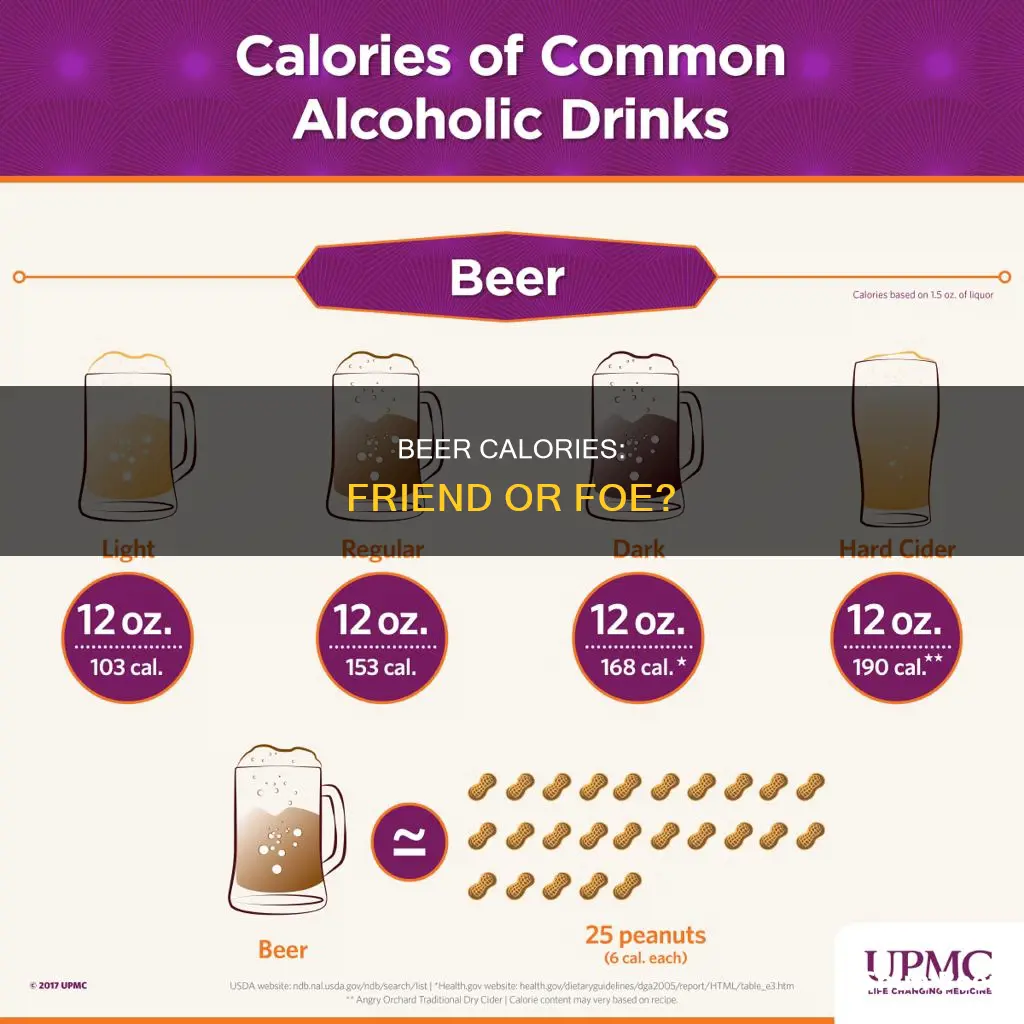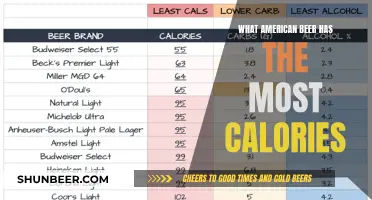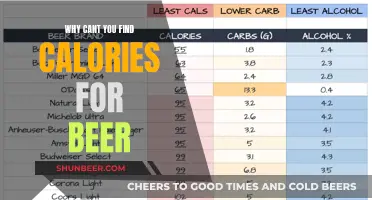
Beer is a popular drink worldwide, but it's also known for being high in calories. A typical 12-ounce beer has about 140 calories, which is similar to a can of Coke. The calories in beer come mainly from alcohol and carbohydrates. The more alcohol in a beer, the more calories it will have. For example, a beer with 5% alcohol by volume (ABV) will have around 150 calories per 12 ounces. Beers with a higher alcohol content, such as IPAs, can have 200 to 300 calories, while low-calorie beers tend to have an ABV of 4.5% or less. The type of beer also makes a difference; lagers usually have fewer calories than ales, and ales typically have fewer calories than stouts.
What You'll Learn

Beer calories depend on alcohol content and carbohydrates
Beer is made from fermented grains, such as barley and wheat, which contain carbohydrates. The calorie content of beer is dependent on its alcohol levels and sugar/carbohydrate content. Alcohol has the most significant impact on calorie count, as it contains more calories per gram than carbohydrates. Beers with higher alcohol content tend to have more calories than lighter ones. For example, a classic beer with an average alcohol content of around 5% has about 43 kilocalories per 100ml.
Additionally, beers with added sugars have extra calories. The number of grains and added sugars in beer varies according to the fermentation process. As a result, different beers have varying carbohydrate levels. For instance, a 12-ounce serving of Bud has 6.6 grams of carbohydrates and 4.2% alcohol by volume (ABV). In contrast, a 12-ounce serving of Miller High Life Light has less than 1 gram of protein and a lower ABV.
The prevailing opinion is that darker beers with denser heads contain more carbohydrates and calories. However, this is not always true, as some lighter-coloured beers use higher levels of sugar, resulting in a higher calorie count. For example, beers like Peroni, Kronenbourg, Budweiser, Heineken, and Stella Artois deliver significantly more calories than Guinness.
When it comes to reducing calorie intake, non-alcoholic beers are a good option, as they usually contain fewer calories. Additionally, "light" beers typically have lower alcohol content, which leads to fewer calories. However, it's important to note that the term "light" can be misleading, as it doesn't always indicate a lower calorie count compared to other beers without the term in their name.
Overall, beer calories depend on both alcohol content and carbohydrate levels, with alcohol having a slightly larger impact on the total calorie count.
Calorie Counting: Wild Blue Beer's Nutritional Breakdown
You may want to see also

Beer is higher in calories than wine and spirits
The calories in beer come mainly from carbs and alcohol. The more alcohol a beer contains, the more calories it will have. Beers with added sugar will also have extra calories. A beer with 5% ABV has about 43 calories per 100ml, while a beer with 4% ABV has about 34 calories per 100ml.
Compared to other alcoholic drinks, beer is one of the drinks with the least calories. Some other low-calorie alcoholic drinks are cider, prosecco, wine, champagne, and sangria. Alcoholic beverages with the highest calories include absinthe, sambuca, Baileys, pastis, amaretto, and gin. For example, a regular beer has 43 calories per 100ml, while absinthe has 348 calories per 100ml.
The colour of a beer can also indicate its calorie content. The prevailing opinion is that the darker the beer and the denser the head, the more calories it contains. However, this is not always the case. For instance, Budweiser (4.5% ABV) and Stella Artois (4.8% ABV) have significantly higher calories than Guinness.
Guinness Beer Calories: How Many in Each Pint?
You may want to see also

Calories from beer don't provide energy for the body
Beer is a popular drink that has been enjoyed for thousands of years, but it is important to understand the impact it can have on our bodies and weight management. While beer does contain calories, the idea that these calories provide energy for the body is misleading. Here's why:
Firstly, it is important to understand that the calories in beer come primarily from two sources: carbohydrates and alcohol. The alcohol content in beer varies, with stronger beers containing more calories. Additionally, beers with added sugar or high levels of sugar, such as Peroni, Budweiser, and Heineken, have a higher calorie count. However, the impact of these calories on our bodies is not as straightforward as it seems.
When we consume beer, or any alcoholic beverage, our bodies prioritize processing and eliminating the alcohol due to its toxic nature. This means that our metabolic systems temporarily pause their regular functions, such as burning calories from food, to focus on getting rid of the alcohol. This interruption in metabolism results in the storage of recently consumed food as fat. So, while the calories from beer may provide some energy, the body's focus on processing alcohol disrupts our normal energy utilization and can lead to increased fat storage.
Furthermore, the calories from beer are not efficiently utilized by the body as energy. Alcohol is almost never fully metabolized by the body and is often excreted as acetic acid. This means that we do not extract the theoretical maximum of 7 calories per gram from alcohol. Instead, we absorb a lower amount, and the excess calories are excreted. This excretion process becomes more prominent when drinking heavily, as the body needs to eliminate larger amounts of alcohol. As a result, the calories from beer are not efficiently converted into energy for the body.
The impact of beer calories on our energy levels is further complicated by individual factors. For example, drinking a small amount slowly might result in the body digesting most of the alcohol as energy. On the other hand, drinking heavily can lead to the excretion of a more significant number of calories, reducing their overall impact. Additionally, factors such as age, gender, and physical activity levels can influence how the body processes and utilizes the calories from beer.
In summary, while beer contains calories that can provide some energy, the body's priority is to process and eliminate alcohol as a toxin. This disruption in metabolism can lead to increased fat storage. Additionally, the inefficient metabolism of alcohol results in the excretion of excess calories, further reducing their availability for energy production. Therefore, it is important to understand that the calories from beer do not provide a substantial or sustainable source of energy for the body, and excessive consumption can lead to weight gain and other negative health consequences.
Blueberry Beer Calories: Wachusett's Sweet Secret Revealed
You may want to see also

Non-alcoholic beers have some health benefits
Beer is a popular drink worldwide, but it is often associated with weight gain and health issues. However, non-alcoholic beers have emerged as a healthier alternative, offering several benefits without compromising on taste. Here are some reasons why non-alcoholic beers are a good choice:
Hydration and Rehydration:
Non-alcoholic beers are excellent for hydration, outperforming even water in this regard. They contain essential electrolytes, and their low alcohol content means they don't have a diuretic effect, so they won't leave you dehydrated like regular beers. This makes them a great option for athletes and fitness enthusiasts.
Improved Sleep and Reduced Stress:
The hops in beer, non-alcoholic or otherwise, contain compounds like xanthohumol and myrcenol, which have a sedative effect and can improve sleep quality. Non-alcoholic beer has been shown to help people fall asleep faster and experience less restlessness during the night. Additionally, drinking non-alcoholic beer in the evening has been linked to reduced stress and anxiety levels, thanks to its effect on decreasing neural activity and relaxing the brain.
Cardiovascular Benefits:
Non-alcoholic beers are believed to have a positive impact on cardiovascular health. The polyphenols in the beer, such as polyphenol xanthohumol, can help reduce blood pressure, inflammation, and homocysteine levels. They also increase endothelial progenitor cells, which are stem cells responsible for repairing and maintaining the endothelial walls of blood vessels. This, in turn, may lower the risk of atherosclerosis, reducing the chances of a heart attack or stroke.
Bone Health:
Silicon, a component of non-alcoholic beer, is essential for boosting collagen production, which leads to healthier bones, blood vessels, hair, skin, and nails. Regular consumption of non-alcoholic beer may play a role in preventing osteoporosis and reducing the risk of bone fractures.
Nutritional Benefits:
Non-alcoholic beers are a good source of essential vitamins and minerals. They contain trace amounts of B vitamins, calcium, potassium, zinc, selenium, and iron. While regular beers also have some nutritional value, the absence of alcohol in non-alcoholic beers makes these nutrients more accessible to the body.
While non-alcoholic beers offer these benefits, it's important to remember that they are not entirely calorie-free or carb-free. Some non-alcoholic beers may also contain added sugars, so checking the labels is always a good idea. Nonetheless, when consumed in moderation, non-alcoholic beers can be a healthier alternative to regular beers, providing similar enjoyment with reduced health risks.
Calories in Beer: Understanding the Count in Your 20oz Pint
You may want to see also

Lagers have fewer calories than ales
Beer is a popular alcoholic drink worldwide and has been for generations. It is the third most popular drink globally after water and tea. Beer is made from fermented grain, and the calories in beer come mainly from carbs and alcohol. The calorie count in beer is dependent upon alcohol levels and sugar/carbohydrate content, with alcohol having the most impact due to the higher number of calories per gram in alcohol (7) than carbs (4).
Lagers and ales are two of the most popular types of beer, and they can have different calorie counts. Generally speaking, lagers tend to have fewer calories than ales. However, this isn't always true. It depends on how much ABV (alcohol by volume) each type has, so it's important to check before you buy. For example, a pint of lager beer can contain 180 calories, the equivalent of a slice of pizza, while stouts and ales can be as calorific as a whole bagel (about 250 calories).
The prevailing opinion is that the darker the beer and the denser the head, the more carbs and calories it contains. However, this isn't always the case. For instance, using the MyFitnessPal database, it was found that beers such as Peroni, Kronenbourg, Budweiser, Heineken, and Stella Artois deliver a significantly higher number of calories than Guinness due to their higher levels of sugar.
If you're watching your weight but still want to enjoy a beer, it's best to opt for a low-calorie beer. Most people prefer to drink crisp beers with a light and clean taste. You can find pale, amber, and dark varieties with 55 to 124 calories per 12 ounces (354 ml). Budweiser Select has only 55 calories and 2.4% alcohol, while the most caloric in this group is Samuel Adams with 124 calories and 4.3% alcohol.
If you're looking for a low-calorie beer, you can also find some excellent options in the lager style. For example, Skinny Lager has 39% fewer calories than a bottle of Kronenbourg and 34% fewer calories than a bottle of Heineken.
So, if you're looking to cut down on calories but still want to enjoy a beer, consider opting for a lager over an ale, checking the ABV, and choosing a low-calorie option.
Light Beer, Big Calories: Corona Light's Carbs Count
You may want to see also
Frequently asked questions
Beer is high in calories compared to other beverages, including wine and spirits. A 12-ounce beer that is 4% ABV has about 150 calories. However, compared to other alcoholic drinks, beer is one of the drinks with the least calories.
The number of calories in beer depends on the alcohol content and, to a lesser extent, the carbohydrate content. Beers with higher alcohol levels have more calories, and beers with added sugar also have extra calories.
Beer has fewer calories than drinks like absinthe, sambuca, baileys, pastis, amaretto, and gin. For example, a regular beer contains 43kcal per 100 ml, while absinthe has 348kcal per 100 ml.
To reduce your calorie intake when drinking beer, you can opt for low-calorie beers, drink in moderation, choose low-ABV beers, or pair your beer with healthier food options.







